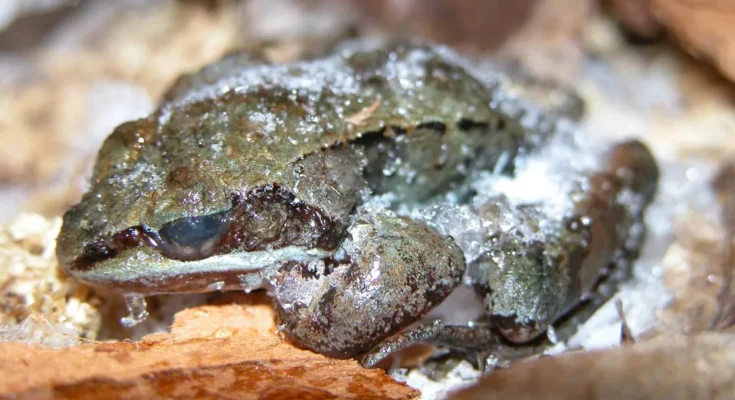Imagine a world where temperatures dip to bone-chilling lows, reaching as frigid as -80°F (-62°C). A world where the land is encased in a thick blanket of snow and ice, and the very essence of life seems to have been frozen in time. Yet, amid this frozen environment, a remarkable creature thrives – the wood frog.
This unassuming amphibian, which has a broad distribution over North America, has evolved an extraordinary ability to survive the harshest of winters, defying the laws of nature as we know them. Unlike most creatures that seek refuge from the cold, the wood frog embraces it, undergoing a process that would be fatal for most other animals – it freezes solid.
As winter approaches, the wood frog prepares for its remarkable hibernation. It nestles into the leaf litter on the forest floor, seeking insulation from the overlying snow. But this is no ordinary slumber, as temperatures plummet, the frog’s body begins to freeze.

The process is nothing short of incredible. Ice crystals form between the layers of skin and muscle, encasing the internal organs. Even the eyes turn white as the lens freezes. For all intents and purposes, the wood frog appears to be a lifeless lump of ice, carved into the shape of an amphibian.
Yet, within this frozen exterior, a remarkable dance of survival unfolds. The frog’s liver kicks into overdrive, producing massive amounts of glucose that flush into every cell in its body. This syrupy sugar solution acts as a cryoprotectant, preventing the cells from freezing and binding the water molecules inside, preventing dehydration.
In most animals, prolonged exposure to subzero temperatures causes cellular shrinkage – a process where ice formation in the tissues pulls water from the body’s cells, essentially sucking them dry and eventually killing the cell. But the wood frog’s cryoprotectants help its cells resist this shrinkage. The solutes depress the freezing point of tissues, limiting how much ice actually forms in the body. The more cryoprotectants like glucose the wood frog can accumulate, the less ice will form, reducing stress on cells and tissues.




